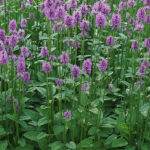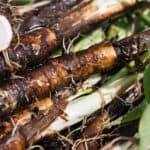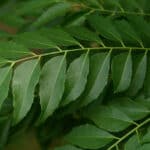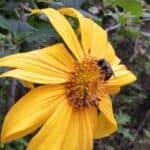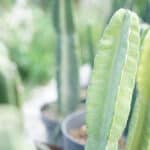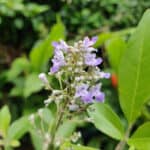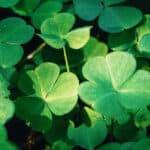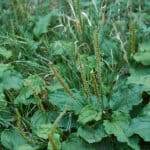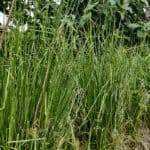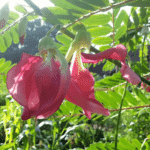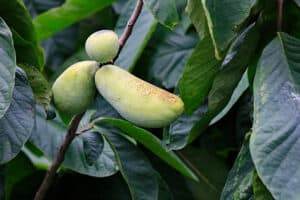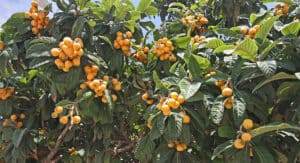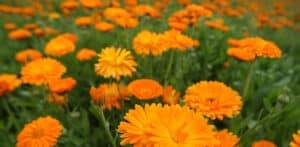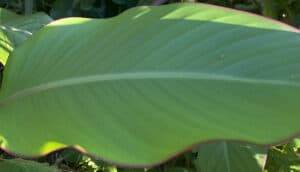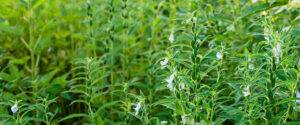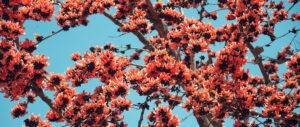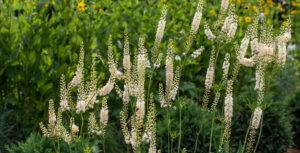Short-lived with a Long-Lasting Impact
Growing up I remember paddy fields and farm boundaries turning yellow for several weeks in winter with a view of bright yellow flower patches. On taking a closer look, these flowers appear like little birds sipping nectar with their sunbird-like beak.
This is Sunhemp, a beloved quick-growing cover crop grown by our farming communities for its diverse applications like green manure, cattle fodder and plant-based fiber.
Originating from India and adjoining countries, it is now cultivated across the tropical and subtropical regions and is naturalized in China, Korea, America, Romania and Russia.
The botanical name is Crotalaria juncea and is commonly known as rattle pods, brown hemp, Indian hemp or Madras hemp. It’s called Sanai in Hindi and we call it Taag or Taagi in our native language, Marathi. The genus name means “rattle”, relating to the seed pods producing rattling sounds at maturity.
Quick fact: Sun hemp fiber is called ‘sana’ in Sanskrit and it is one of the earliest named fiber.
The fiber has gained traction since the early 2000s due to the emerging concerns around environment-friendly fiber production and plant-based alternatives. It is yellowish brown in color and is known for its high-quality coarse and strength. The fineness lies in between jute and cotton, finer and stronger than jute, not as fine as cotton and not as strong as hemp (Cannabis sativa). Thus the application of this fiber is different than other plant-based fibers. It is used for making cordage, fishing nets, floor mats, canvas, paper pulp, ropes, and more across India.
It is a tropical annual herbaceous shrub belonging to the family Fabaceae. It grows up to 1 to 4 meters tall with a strong and deep tap-root system with several lateral roots.
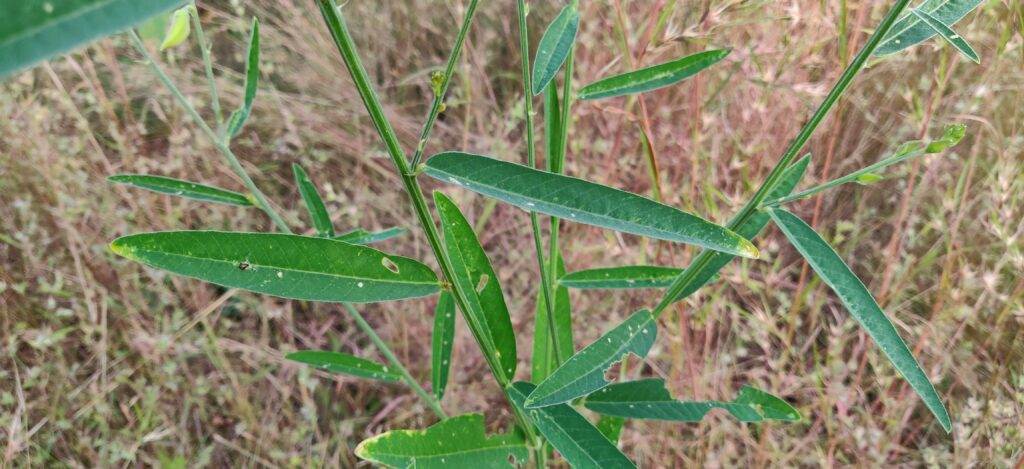
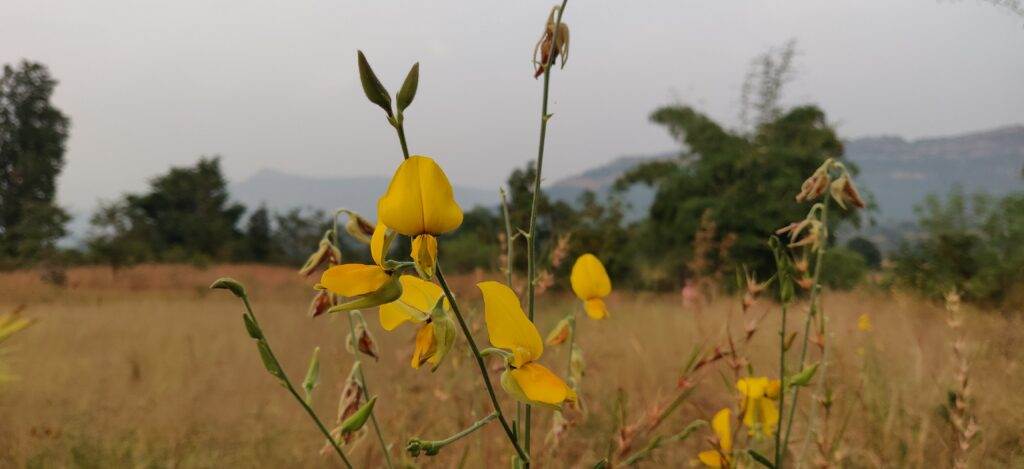
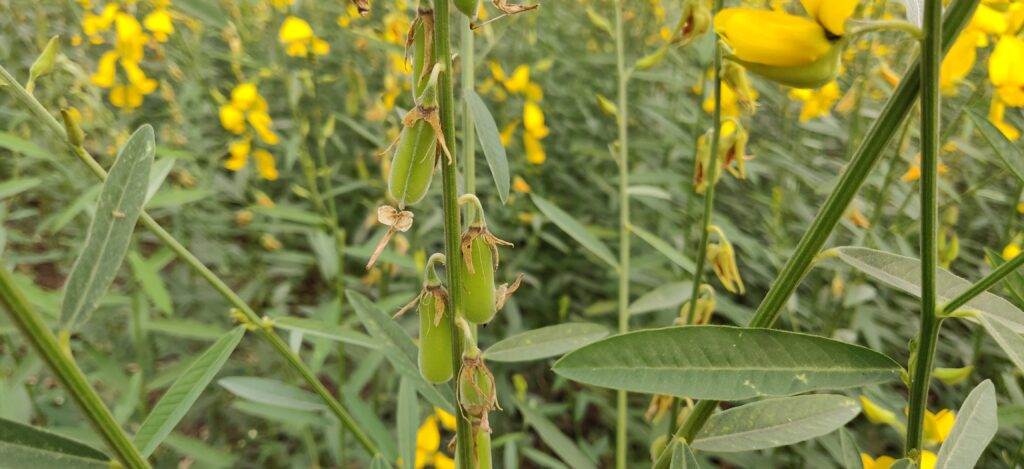
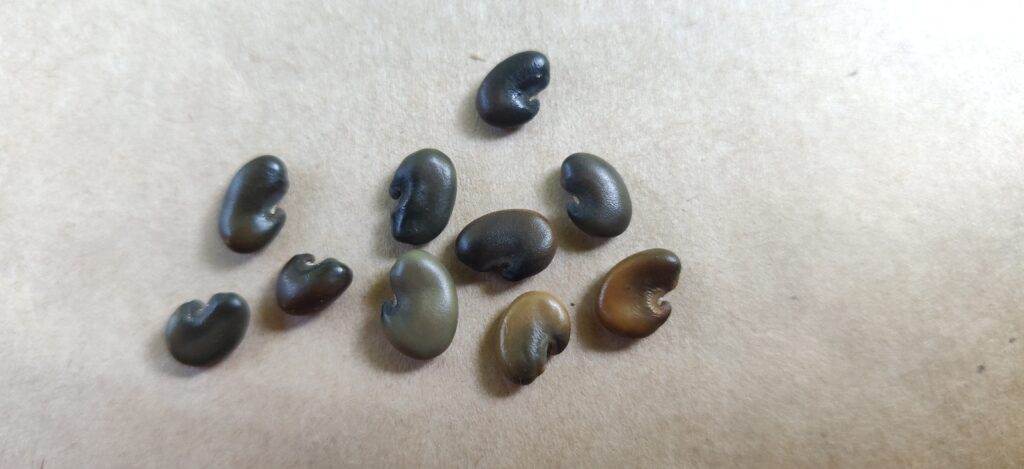
The plant is grown at elevations up to 1500m and annual rainfall ranging between 300 to 1500mm however can tolerate upto 4000mm as well.
Traditional Regenerative Properties of Sunhemp
It’s a warm-season crop that can fix its own nitrogen, thus growing it in progression helps add nitrogen to your ecosystem. The magnificent yellow flowers make it pretty obvious about the potential of attracting pollinators to the fields however, the traditional wisdom covers the various regenerative properties of this plant and its applications. As farmers, we have evolved to get creative with broadcasting the seeds in certain patterns around the farms and it depends on the purpose that we are looking forward to serving.
Below is a list of the regenerative properties of Sunhemp and including ways of sowing and harvesting for respective purposes.
Windbreak and pest moment interrupter
Traditionally, sunhemp can be seen planted in rows as a boundary around the main crop to help reduce the speed of wind in the corresponding fields and to interrupt the movement of pests which helps reduce the risk of spreading diseases.
It helps form barriers in-between adjacent fields during winters when most of the vegetables are planted. It acts as a low-budget and affordable solution as the paddy field usually has a commonly shared fence around the boundary however not much of perennials in-between adjacent fields that can act as a physical barrier.
In such situations of shared fencing, the hemp-based breaks help slow down the wind and the moment of pests in adjacent fields.
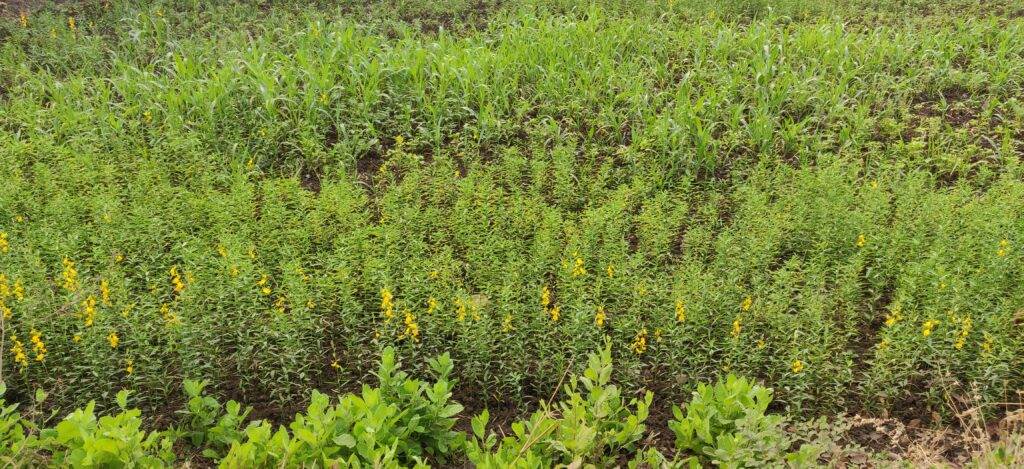
Nitrogen Fixer
Belonging to the leguminous family, sun hemp form root nodules where the Rhizobium bacteria transform atmospheric nitrogen into ammonia. This helps the plant grow quickly and fix nitrogen in soils, making it plant available for the next crop.
In this case, the plants are pruned at the flowering stage and left to decompose in the field as residues followed by plantation of the next catch crop which is mostly vegetables, rice or wheat.
Green manure
Being a quick-growing legume, the bush can be pruned post the 6th to 8th week of sowing for mulch or tilling back into the soil. In its lifetime of 5 to 6 months (depending on the variety and soil type) the forage can be harvested 3 to 4 times.
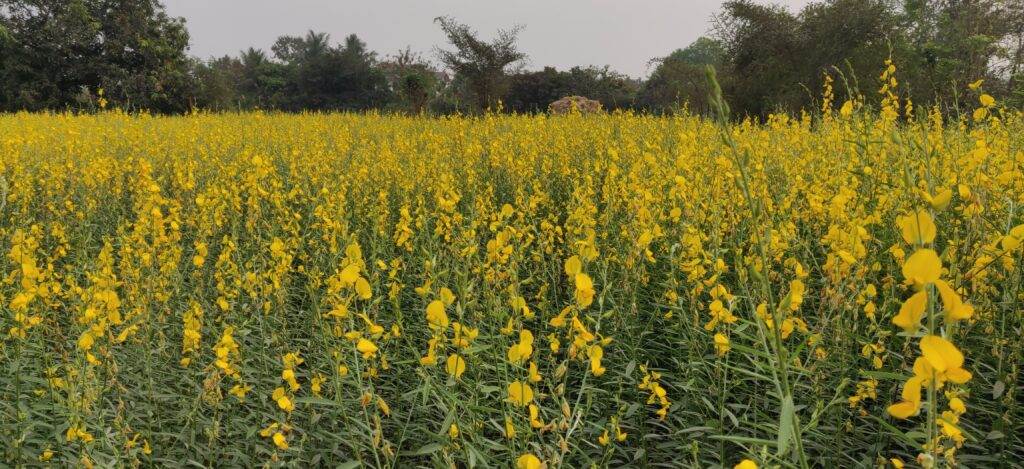
It is plowed in the flowering stage for faster decomposition. The foliage adds nutrients and organic matter to the soil and helps enhance the soil’s microbiota. It can be left in the soil for longer durations for better soil fertility.
The plants might need irrigation when grown for green manure, twice to thrice based on the soil’s moisture retention behavior and overall weather conditions.
Fodder
Similarly, the forage can be harvested multiple times and is highly proteinaceous. It is a preferred one for milking cattle. In fact, some farmers dedicate patches entirely to fodder. It is fed fresh and the forage is also dried into hay and later mixed with other seasonal fodder.
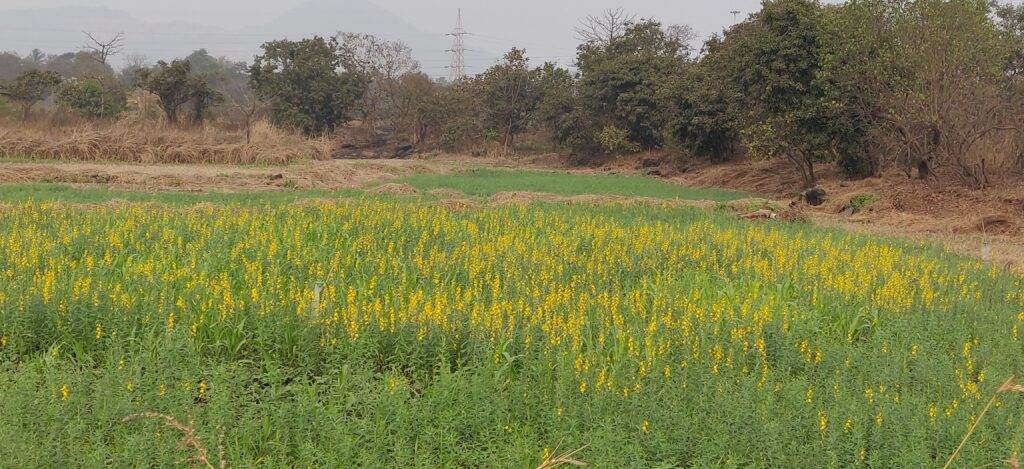
The forage is harvested before the seeding stage (35 to 40 days post planting ) as the seeds have some level of toxicity, trichodesmine is the principal toxic alkaloid present in the seeds and thus is not recommended for cattle, especially horses and pigs.
Harvesting tip: harvest at 1 foot above ground to facilitate regrowth and wider spread.
Suppressing Nematodes
Sunhemp can disrupt and suppress parasitic nematodes by the allelochemicals it produces which exerts a detrimental effect on the nematode lifecycle. This helps increase rotational crop yields and reduce invertebrate pest pressure in traditional crop rotation.
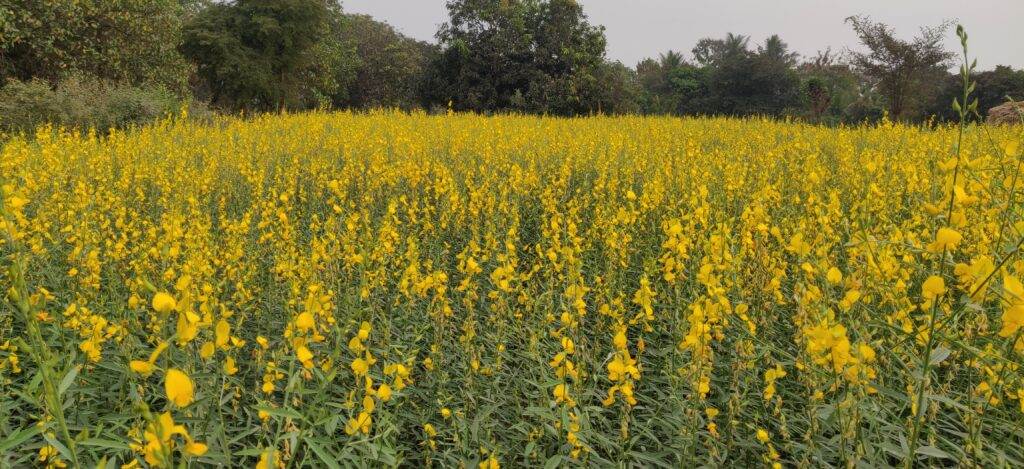
In this case, the seeds are planted around the whole field, it is communicated with the community to do so for a specific year to tackle the problem together.
Drought and low fertility tolerant
Once established, the shrub is drought-tolerant. It can grow in diverse soil pH ranges from 5 to 8, is tolerant of low soil fertility and doesn’t need external irrigation if planted at the right time, this depends on the soil type as well.

Natural Fibre
Sunhemp fiber is softer than jute making it suitable for both clothing and farm use. Traditionally it was woven into ropes or threads and used to create other products later, which basically helps meet the needs of farming communities from within the system.
The fiber is also very suitable for paper making due to the length-to-width ratio of bast fibre that helps achieve a better size of paper.
Other Uses
- The flowers are made into sauteed dry vegetable dishes during scarcity.
- The plant is used as a weed suppressant.
- The seeds are processed and used in traditional medicine to purify the blood and in the treatment of psoriasis.
However, despite the numerous benefits including traditional fiber extraction, cultivation is decreasing rapidly.
Growing and Caring for Sunhemp
Being a low-maintenance annual, it’s really easy to grow, harvest, and store this plant. However, it’s recommended to monitor the impact as the quick-growing one can go invasive as well when introduced to non-native zones.
Interesting Fact: Being a short-day crop it is sensitive to photoperiod, it doesn’t flower successfully if the sunlight is more than 12 hours. Long day lengths favor vegetative growth and reduce seed set thus the chances of it going invasive are lower. That’s one of the reasons why it’s cultivated in winter in India when the days are shorter, between 10.5 to 11 hrs.
Ways to include Sunhemp in your choice of space:
- As a cover crop in the field.
- In between seasonal crops in crop rotation.
- Under your existing trees in the food forest or as at bush level in multilayer farming.
- In your vegetable garden, along the boundaries or in between the rows.
- In your pots as companions and nitrogen-rich mulching sources for existing plants.
Propagation
Propagation is from seeds and there are no hard and fast rules for sowing. As it’s a warm-season crop, it can take anywhere around 4 days to a week for germination depending on the soil temperature.
The seeds can be randomly broadcasted on slightly tilled soils, or manually an inch deep into soils. The seeds falling on the surface germinate as well. Anything works as long as the soil is moist but not waterlogged as too much water post-germination can kill the plants. Thumb rule, don’t irrigate once you see the first two leaves emerging.
In our areas, especially in paddy farming communities, the seeds are scattered when the fields have residual moisture post-paddy harvest. This enables the crop to grow without external irrigation and with low physical effort.
If you are growing it around your existing plants in a food forest, look for spots that receive 5 to 6 hours of sunlight and sow the seeds by loosening the soil.
If you are planting it as a cover crop in the fields, you can aim at getting 15 to 20kg of seeds per acre. The seeds are available online or can be sourced from farmers from your zones.
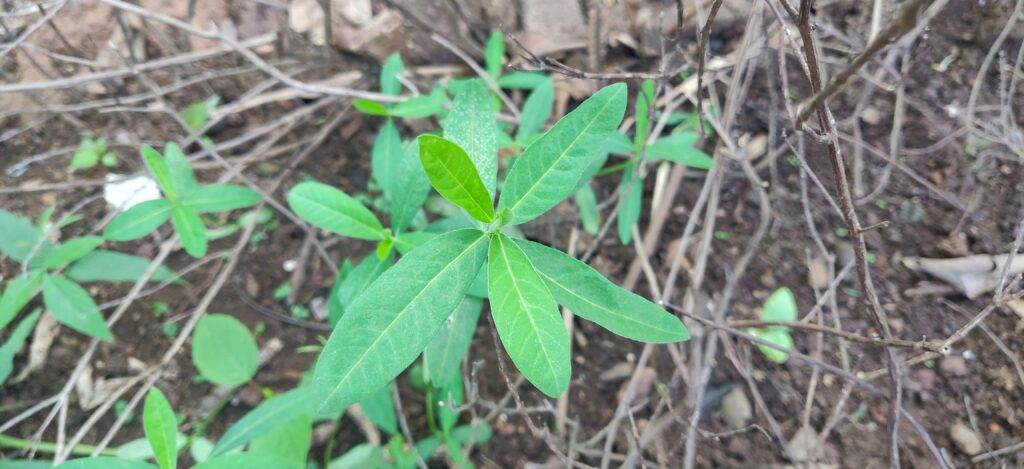
Once the plant starts growing, you can stop irrigating post-successful germination and when the first true leaves are established. Further, if you wish to harvest it for forage, you can water it after harvesting the forage to increase the production of new green foliage or leave it so that it flowers and seeds.
You can save a patch for seeds when you are growing it as a cover crop or for green manure.
Overwatering Concerns: It can stress the plant, in fact, it hinders flowering and fruiting cycles and yields as it cannot withstand waterlogging and has limited tolerance towards salinity.
Harvesting and Storage
Sunhemp is harvested for multiple purposes like seeds, which are stored for the next year or sold in the local market for fiber, fodder, foliage, and more.
For Seeds
The seed pods are allowed to dry on the plant naturally and harvested when the pod start rattling and before they pop open, this helps the pods from breaking during harvesting. It takes around 120 to 150 days for seed maturation.
Rattling is an interesting indicator to remember the right time to harvest.
Traditionally plant is cut by hand with a sickly, made into bundles and thrashed. The thrashed material is winnowed in wind for separating the seeds and husk. The seeds are stored in gunny sacks. The husk is used as mulch.
For Fibre
The plant is harvested before or during the flowering stage, however, depending on the priority, it’s harvested later when the seed pods are ripe as well.
The Traditional Process
Traditionally the fiber is obtained by retting, a method that helps extract fiber with the help of microbes in water, especially muddy water like paddy fields, ponds, rivers and more. The plant has 2 fibers, bast which is the outer longer fiber and the core inside. The retting helps extract the bast fiber.
The stems are cut from the base with a sickle and bundled together. The leaves and seed pods are removed manually and the ones of the same height and thickness are bundled together.
Then the bundles are submerged in water, stones are added as a weight to keep the bundles submerged underwater for around a week or more. However, the resting time depends on the stems’ size, thickness, water or soil pH, temperature, weather and more. Thus the time and process differ slightly as we move across different locations.
Microbial growth is a must for retting and thus in case of water scarcity, the bundles are left in the paddy fields until monsoon.
Post which the bundles are taken out and the fiber is extracted by hand by slightly breaking the top and pulling the bast fiber down. The fiber is then knotted at one end and left to dry on trees near the field or on ropes.
The dry fiber is then dipped into ash and water solution for conditioning it to make it smooth enough to be knitted into ropes. It is spun through traditional wooden frame-based setups for making threads which are then used for making other products.
The threads and ropes are both, sold in the market and used in farms for diverse purposes like tying cattle, making woven cots, general tying and bundling and more.
This entire process is traditionally done by hand; thus, it is a community participation activity that demands the involvement of everybody. However, being a time and labor-intensive process which depends highly on the availability of water for retting, it is rapidly disappearing due to reducing the participation of communities due to limited participation, rainfall scarcity, migration to cities for job opportunities and income, availability of synthetic fiber in local marker as a cheap alternative and more. Thus it becomes important to encourage and practice and preserve these slow and conscious methods.
Conclusion
Sunhemp has always been a subtle affordable solution, standing tall with the small-scale communities however we are slowly losing access to the wisdom of these traditional practices. Thus, I hope this article encourages you to include sunhemp, save and share the seeds and their wisdom, and most importantly, advocate for its potential as a great source of natural fiber and all of these crazy regenerative properties 🙂

